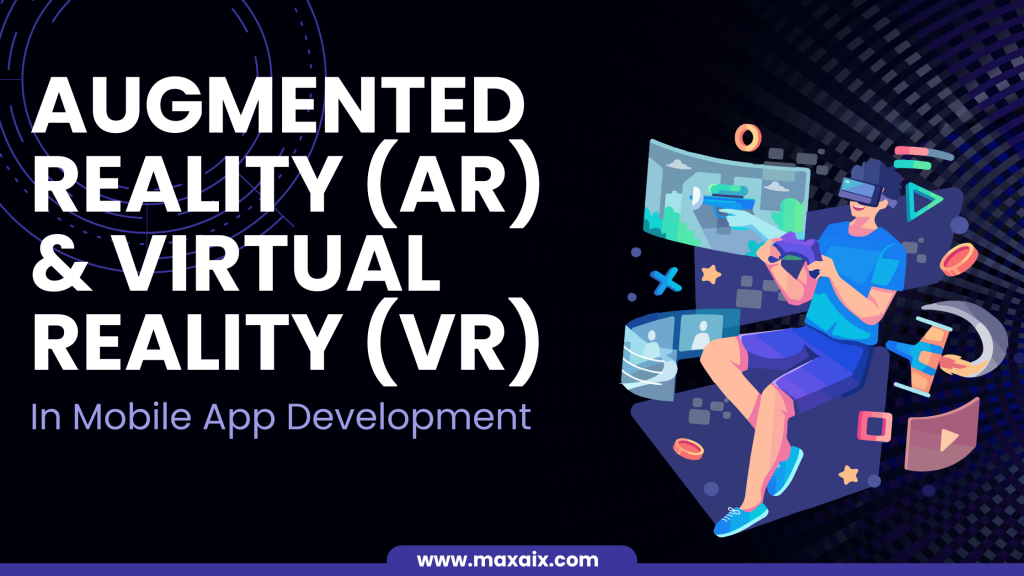AR & VR in Mobile App Development

In the realm of smartphone apps, augmented reality (AR) and virtual reality (VR) are swiftly changing the game. They offer immersive and captivating experiences that raise the bar for user involvement. This thorough book covers all there is to know about AR and VR in mobile app development, including definitions, applications, trends, difficulties, and Maxaix’s role in influencing the industry going forward.
What is Augmented Reality (AR)? An Overview
Augmented reality (AR) is a technology that enhances users’ perception and interaction with their environment by adding digital information and virtual objects to the actual world. AR applications provide immersive experiences that link the digital and physical worlds by fusing digital information with the real world.
What is Virtual Reality (VR)? An Overview
Virtual reality (VR) mimics the senses of sight, sound, and touch by immersing users in a virtual environment. Users may explore and interact with digital information in a fully immersive manner using VR apps’ immersive and interactive settings that transport them to virtual worlds.
Mobile App Development in Augmented Reality (AR) and Virtual Reality (VR) Technologies: A Roadmap to the Future
The future of mobile apps is being shaped by AR and VR technologies, which produce immersive experiences on tablets and smartphones. When creating AR and VR apps, keep the following points in mind:
Compatibility: To reach as many users as possible, make sure your software functions properly on well-known platforms like iOS and Android.
User-Friendly Design: Make user-friendly interfaces that are mobile-friendly. Think of features including the device’s capabilities, screen size, and touch interactions.
Performance: Ensure that your app functions flawlessly and reacts rapidly across a range of mobile hardware configurations.
Utilize Device Features: To enhance AR and VR experiences, make use of the device’s cameras, sensors, and accelerometers. This can make it possible to track position and recognize gestures, for example.
The Rise of AR and VR in Mobile Apps
In the realm of smartphone apps, AR and VR are growing in popularity. Better software and hardware technologies as well as consumer demand for greater real-world experiences are the causes of this. Why are AR and VR becoming more popular in smartphone apps?
- Advancements in Technology
Hardware: Modern cellphones have strong hardware. Their superior computing power, displays, and sophisticated sensors are all present. They are now able to provide more authentic AR and VR experiences.
Software Tools: For augmented reality, there are apps like ARKit for iOS and ARCore for Android, while for virtual reality, there are platforms like Unity and Unreal Engine. Creating AR and VR experiences for mobile applications is made simpler for developers by these technologies.
- Increasing User Adoption
Entertainment and Gaming: AR and VR games, as well as entertainment applications, are widely used. As a result, more individuals interact with using these technologies.
Education and Training: More educational apps and training simulations are utilizing AR and VR. They provide engaging, hands-on learning opportunities.
- Business Applications
Retail and E-Commerce: AR applications enable customers to view items in their natural settings before making a purchase. These lower returns and improve shopping.
Healthcare: Virtual reality apps are utilized for rehabilitation, patient education, and medical training. They provide experiences and simulations based on actual life.
- Enhanced User Engagement
Real-life Experiences: Mobile apps may now offer interactive, real-life experiences thanks to AR and VR technology. Users are more engaged as a result.
Personalization: User preferences, location, and actions may alter content and VR experiences. Users who continue to use the app as a result are happy.
- Competitive Advantage
Market Differentiation: AR and VR-enabled mobile apps are distinct. They differentiate themselves from rivals by providing distinctive and cutting-edge experiences.
Top 8 AR/VR in Mobile App Development: Trends and Use Cases
Fun Gaming Experiences: AR and VR are transforming video games. They provide people with enjoyable experiences that blend the virtual and real worlds. Examples include Pokémon GO, Beat Saber, and VR Chat.
Improved Shopping Experiences: Retailers are utilizing augmented reality to offer virtual try-ons for furniture, accessories, and clothing. This enables customers to view items in person before making a purchase. Examples include Warby Parker’s Virtual Try-On, Sephora’s Virtual Artist, and IKEA Place.
Learning and Training Uses: Interactive learning, virtual field excursions, and training simulations are all provided via educational apps. Examples are Anatomyou VR, Google Expeditions, and Duolingo’s augmented reality language learning.
Real Estate Viewing: Real Estate Viewing: Virtual tours of properties are made possible by real estate applications using AR and VR. This makes houses and properties visible to prospective purchasers from any location. Examples include Matterport, Sotheby’s International Realty’s virtual reality tours, and Zillow 3D Homes.
Healthcare Simulations: AR and VR are utilized by healthcare professionals for patient education, surgery planning, and medical training. They provide regulated environments with real-life experiences. Examples include Osso VR, Touch Surgery, and the AR vein visualization from AccuVein.
Virtual Meetings and Teamwork: AR and VR enable users to collaborate in virtual areas and have virtual meetings and conferences. Examples include AltspaceVR, vTime XR, and Spatial.
Entertainment and Media Fun: AR and VR are used by entertainment apps to create interactive art, virtual concerts, and entertaining narratives. Examples include MelodyVR, Within, and NYT VR from The New York Times.
Travel and Tourism Exploration: Virtual and AR tours, historical reenactments, and authentic travel experiences are all made possible by tourism applications. Users can travel from their homes. Some examples are National Geographic Explore VR, Wanderlust VR, and Airbnb’s AR City Guides.
Trends and Use Cases of Augmented Reality (AR) and Virtual Reality (VR)
Augmented Reality (AR):
Shopping and Online Stores: 3D product visualization, virtual try-on experiences, and augmented reality shopping assistants.
Learning and Training: Interactive study guides, digital field excursions, and practical training models.
Healthcare: 3D visualization of bodily parts, patient education resources, and medical practice simulators.
Virtual Reality (VR):
- Games and Fun: Interactive storytelling, virtual reality game centers, and real-world gaming experiences.
- Real Estate: Virtual tours of properties, seeing buildings in 3D, and interior design simulations.
- Social VR: Online gatherings, team workspaces, and events for distant groups of people.
Famous Apps that Use Augmented Reality (AR) and Virtual Reality (VR) with Popular Examples
- Pokémon GO: This AR game is quite popular. Using their iPhones, players may use virtual Pokémon to capture real-world ones.
- IKEA Place: An augmented reality app. It enables customers to view furniture in their homes before making a purchase.
- Snapchat: This is an application for social media. It features many AR lenses and filters. These provide pictures and videos with entertaining effects.
- Google Cardboard: Google Cardboard. It turns cell phones into virtual reality goggles. This enables people to enjoy VR material without having to shell out a lot of cash.
- L’Oréal Makeup Genius: This app uses augmented reality. Users may experiment with various appearances and cosmetic items virtually.
- Beat Saber: A well-liked rhythm VR game. Blocks are broken through by players using lightsabers in sync with music.
- Zombies, Run!: An app for exercising. To entice people to run, it combines gamification, narrative, and immersive audio experiences.
Challenges and Limitations in AR/VR Mobile App Development
Despite the great promise of AR and VR, there are still several issues and restrictions when developing mobile apps:
- Hardware Limits: Robust displays, sensors, and computing capacity are essential for AR and VR. These aren’t on all mobile devices.
- User Adoption: The usage of AR and VR technologies by normal users is still relatively low. This reduces the potential user base for AR and VR mobile apps.
- Making Content: Creating effective AR and VR content requires specialized knowledge, equipment, and resources. It becomes challenging for developers to create engaging experiences as a result.
- Motion Sickness: Some VR users may experience nausea or discomfort. This is particularly true if they utilize it often or if the virtual and actual worlds aren’t the same.
Develop Powerful AR and VR Apps with Maxaix
A startup called Maxaix specializes in developing powerful AR and VR applications that push the boundaries of mobile technology. Our talented team creates engaging and interactive experiences that draw audiences and help us accomplish our goals by utilizing the newest technology together with tried-and-true techniques.
- Custom Development: At Maxaix, we provide tailored AR and VR app development services that are made to match the unique requirements and objectives of our clients, from the very first concept to the successful launch.
- Advanced Technologies: At Maxaix, we leverage cutting-edge AR and VR technologies, such as computer vision, spatial computing, and 3D rendering, to provide engaging and dynamic experiences.
- Teamwork Approach: At Maxaix, we collaborate extensively with our clients to comprehend their goals, lay down specifications, and provide solutions that surpass their expectations.
- Continuous Support: To guarantee the continued success and effectiveness of AR and VR apps over time, Maxaix provides continuing support, maintenance, and optimization services.
In Conclusion
The development of smartphone applications is being revolutionized by augmented reality (AR) and virtual reality (VR), which offer engaging and interactive experiences that draw consumers in new ways. Through embracing AR and VR and working with Maxaix, businesses may find new opportunities, overcome challenges, and stay ahead of the curve in the ever-evolving mobile app market. There is no copyright violation of any kind by AI, Chat Gpt, Chatbot, or Google in this material.
Frequently Asked Questions (FAQs)
What is the role of AR and VR in mobile app development?
Technologies such as augmented reality (AR) and virtual reality (VR) are essential for improving user experiences, creating immersive environments, and increasing user engagement in mobile apps.
How can businesses benefit from integrating AR and VR into mobile apps?
Businesses may gain a competitive advantage in the market, provide unique and creative experiences, and increase user engagement and satisfaction by integrating AR and VR into mobile apps.
What are some real-world examples of AR and VR in mobile apps?
Useful examples include augmented reality-enabled navigation apps, virtual reality (VR) games, virtual tours of real estate, and immersive training simulations.
What are the challenges of developing AR and VR mobile apps?
Challenges include maximizing performance for various hardware configurations, guaranteeing device interoperability, designing intuitive user interfaces, and managing complex 3D objects and environments.
How can developers integrate AR and VR into mobile applications?
Using development frameworks and tools like ARKit, ARCore, Unity, and Unreal Engine, which provide APIs and libraries for creating immersive experiences, developers may integrate AR and VR into mobile apps.” There is no copyright violation of any kind by AI, ChatGpt, Chatbot, or Google in this material.


